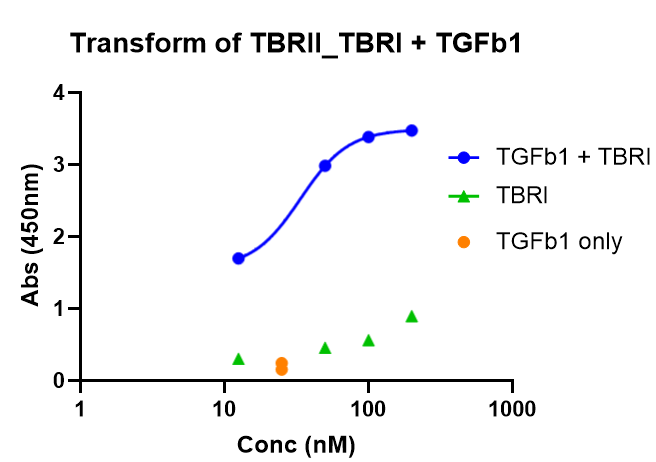Recombinant Human TGF-beta RI/ALK-5 Fc Chimera Protein, CF
Recombinant Human TGF-beta RI/ALK-5 Fc Chimera Protein, CF Summary
Product Specifications
| Human TGF-beta RI/ALK-5 (Ala25-Glu125) Accession # P36897 |
IEGRMD | Human IgG1 (Pro100-Lys330) |
| N-terminus | C-terminus | |
Analysis
Product Datasheets
Carrier Free
CF stands for Carrier Free (CF). We typically add Bovine Serum Albumin (BSA) as a carrier protein to our recombinant proteins. Adding a carrier protein enhances protein stability, increases shelf-life, and allows the recombinant protein to be stored at a more dilute concentration. The carrier free version does not contain BSA.
In general, we advise purchasing the recombinant protein with BSA for use in cell or tissue culture, or as an ELISA standard. In contrast, the carrier free protein is recommended for applications, in which the presence of BSA could interfere.
3025-BR
| Formulation | Lyophilized from a 0.2 μm filtered solution in PBS. |
| Reconstitution | Reconstitute at 250 μg/mL in PBS. |
| Shipping | The product is shipped at ambient temperature. Upon receipt, store it immediately at the temperature recommended below. |
| Stability & Storage: | Use a manual defrost freezer and avoid repeated freeze-thaw cycles.
|
Reconstitution Calculator
Background: TGF-beta RI/ALK-5
TGF-beta RI, also called ALK-5, is an approximately 55 kDa type I transmembrane serine/threonine receptor kinase (1, 2). It contains a cysteine-rich extracellular domain (ECD), a transmembrane helix, and a C-terminal cytoplasmic kinase domain (3). Within the cytoplasmic domain there is also a short, conserved regulatory sequence known as the GS region that is N-terminal to the kinase domain (1). Within the ECD, human TGF-beta RI shares 90% and 88% aa sequence identity with mouse and rat TGF-beta RI, respectively. In the presence of TGF-beta, TGF-beta RI forms a complex with, and is phosphorylated by, TGF-beta RII (1). Phosphorylated TGF-beta RI can then transiently bind and phosphorylate Smad2 and Smad3 (2, 4-6). These phosphorylated Smads form heteromeric complexes with Smad4, translocate to the nucleus, and regulate target gene transcription (2, 4-6). TGF-beta RI is likely important during development, since mice deficient for TGF-beta RI die at midgestation with severe defects in vascular development of the yolk sac and placenta, and an absence of circulating red blood cells (7). Furthermore, TGF-beta RI appears to be involved in proper lymphatic network development (8). Mutations in TGF-beta RI have been identified in pancreatic, colorectal, ovarian, and head and neck cancers (9).
- Wrana, J.L. et al. (1994) Nature 370:341.
- Massagué, J. (2012) Nat. Rev. Mol. Cell Biol. 13:616.
- Huse, M. et al. (1999) Cell 96:425.
- Marcías-Silva, M. et al. (1996) Cell 87:1215.
- Zhang, Y. et al. (1996) Nature 383:168.
- Huse, M. et al. (2001) Mol. Cell 8:671.
- Larsson, J. et al. (2001) EMBO J. 20:1663.
- James, J.M. et al. (2013) Development 140:3903.
- Sheen, Y.Y. et al. (2013) Biomol. Ther. (Seoul) 21:323.
Citations for Recombinant Human TGF-beta RI/ALK-5 Fc Chimera Protein, CF
R&D Systems personnel manually curate a database that contains references using R&D Systems products. The data collected includes not only links to publications in PubMed, but also provides information about sample types, species, and experimental conditions.
2
Citations: Showing 1 - 2
Filter your results:
Filter by:
-
TGF-? contamination of purified recombinant GDF15
Authors: OE Olsen, A Skjærvik, BF Størdal, A Sundan, T Holien
PLoS ONE, 2017-11-21;12(11):e0187349.
Species: Human
Sample Types: Whole Cells
Applications: Bioassay -
Structural basis for potency differences between GDF8 and GDF11
Authors: RG Walker, M Czepnik, EJ Goebel, JC McCoy, A Vujic, M Cho, J Oh, S Aykul, KL Walton, G Schang, DJ Bernard, AP Hinck, CA Harrison, E Martinez-H, AJ Wagers, RT Lee, TB Thompson
BMC Biol, 2017-03-03;15(1):19.
Species: Bacteria - Staphylococcus aureus
Sample Types: Recombinant Protein
Applications: Bioassay
FAQs
No product specific FAQs exist for this product, however you may
View all Proteins and Enzyme FAQsReviews for Recombinant Human TGF-beta RI/ALK-5 Fc Chimera Protein, CF
Average Rating: 4.5 (Based on 2 Reviews)
Have you used Recombinant Human TGF-beta RI/ALK-5 Fc Chimera Protein, CF?
Submit a review and receive an Amazon gift card.
$25/€18/£15/$25CAN/¥75 Yuan/¥2500 Yen for a review with an image
$10/€7/£6/$10 CAD/¥70 Yuan/¥1110 Yen for a review without an image
Filter by:
Reason for Rating: ELISA assay. TGFb3 binds to immobilize TBRII, followed by different doses of TBRI. Recruitment of TBRI was seen when TGFbeta and TBRII are complexed.






